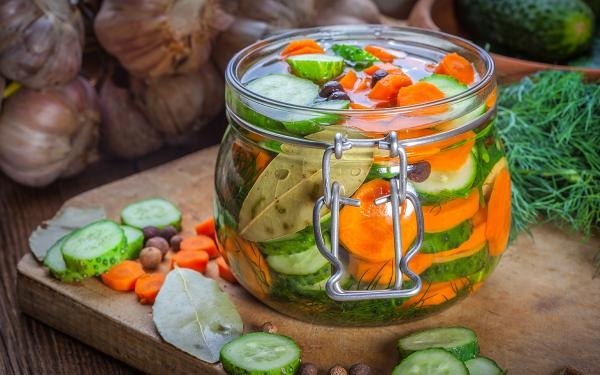E IS FOR ENCURTIDO
By:
March 19, 2023

An installment in CONDIMENT ABECEDARIUM, an apophenic food-history series from HILOBROW friend Tom Nealon, author of the seminal book Food Fights and Culture Wars: A Secret History of Taste (2016 UK; 2017 US); and also — here at HILOBROW — the popular series STUFFED (2014–2020) and DE CONDIMENTIS (2010–2012).
CONDIMENT ABECEDARIUM: SERIES INTRODUCTION | AIOLI / ANCHOVIES | BANANA KETCHUP / BALSAMIC VINEGAR | CHIMICHURRI / CAMELINE SAUCE | DELAL / DIP | ENCURTIDO / EXTRACT OF MEAT | FURIKAKE / FINA’DENNE’ | GREEN CHILE / GARUM | HOT HONEY / HORSERADISH | INAMONA / ICE | JALAPEÑO / JIMMIES | KECAP MANIS / KIMCHI | LJUTENICA / LEMON | MONKEY GLAND SAUCE / MURRI | NƯỚC CHẤM / NUTELLA | OLIVE OIL / OXYGALA | PIKLIZ / PYLSUSINNEP SAUCE | QIZHA / QUESO | RED-EYE GRAVY / RANCH DRESSING | SAMBAL / SAUERKRAUT | TZATZIKI / TARTAR SAUCE | UMEBOSHI / UNAGI SAUCE | VEGEMITE / VERJUS | WHITE GRAVY / WOW-WOW SAUCE | XO SAUCE / XNIPEK | YOGHURT / YEMA | ZHOUG / ZA’ATAR | GOOD-BYE TO ALL TZAT(ZIKI).

Encurtido is a Central American (especially Honduran) quick pickle made with carrots, onions, and multiple chile peppers — but, as always, with lots of regional and seasonal variations. It’s like giardiniera that didn’t lose sight of the fact that it’s a condiment (cauliflower in vinegar is great and all, but what am I supposed to do with it?). Also, it has chile peppers. Unlike some related condiments (the Haitian put-it-on-everything condiment pikliz comes to mind, or El Salvadorian curtido) it is made with hot vinegar — so the harder vegetables (carrots, etc.) are softened up and it’s ready to eat as soon as it cools. Encurtido is a really nice mixture of the brightness of pikliz and curtido and the slightly more mellow qualities of giardiniera and allows you to taste the individual ingredients a bit more. It does the same job of cutting the fattiness of pork or cheese dishes, or the always-lurking insipidness of beans. while also bringing a depth of flavor.
Like a lot of pickled things, the commercial versions of these are quite good (though it’s easier to find giardiniera), but they are easy to make. Curtido and pikliz are just shredded vegetables (carrots, cabbage, sometimes onion, garlic, and then scotch bonnet for the pikliz and oregano for curtido). Stuff them in a jar and fill with white vinegar. Curtido requires a quick blanch of the beefier veggies, then fill with hot vinegar and store for a couple weeks.
You should eat all three as often as possible, of course. All are great on a hot dog, and a vast improvement over the nonsense they do in Chicago where, in typical Chicago style (e.g. their pizza) they completely misunderstand street food. And don’t forget to use the liquid — put it in your soup, dribble it on your salad, your sandwich.

Towards the end of the 18th century, Antoine Lavoisier destroyed alchemy and declared it the age of chemistry. He had Madame Lavoisier dress in the costume of a priestess and throw the books of the phlogistonic [alchemical] system into the fire whilst a requiem was played. One of those great leaps for mankind moments… but it was, like the Enlightenment itself, largely a marketing scheme. We like to picture these magical events where the world is changed utterly — eurekas and moon landings, internets and steam engines, but it’s really more of a process. Not to belittle Lavoisier’s contributions — he figured out how burning stuff works! And that water isn’t an element! Still, it’s more accurate to view the “chemical revolution” as inextricably linked to alchemy rather than a successor and erasure of it.
Enter Justus Liebig. Liebig actually did see chemistry as continuing alchemy rather than superseding it, and, to prove it, in 1847 developed a process to turn a cow into a bucket of goo with all of the nutritional properties of the cow intact (the official ratio was 36:1 original cow size to goo weight). It was, as Liebig would no doubt agree, a project that had roots stretching back to antiquity.
The Egyptians believed that you could mummify food to ensure its travel to the next world, Judaism sent snacks into the next world by burning them, Catholicism changes bread to flesh, wine to blood. As alchemy moved out of the realm of pure faith, the Greeks took their god, Hermes, and merged him with the Egyptian god Thoth to create the father of all alchemy, Hermes Trismegistus, a figure with three times the power of Hermes and keeper of the secrets of the transmutation of matter. Galen studied the transmutation of food during digestion and compared the workings to an alchemical apparatus: “adjacent viscera like a lot of burning hearths around a great cauldron.” Many attempts to transmute food were based on lingering religious ideas, a desire to recreate the immortality granting food/drink ambrosia or the Biblical manna. Manna was variously described as being like bdellium (a tree resin with the appearance of semi-translucent blackish goo), fine flakes on the ground like frost or white coriander seeds, tasting like wafers made with honey, and like truffles (Dumas described truffles as being the voice of god). Scientists now wonder if it was insects or fungi. A panoply of flavors in one hard-to-pin-down idea.
The most famous medieval alchemist, Paracelsus, did Galen one better and believed that an immaterial principle which he called “the alchemist” lived inside every person and turned food into body. It was these fanciful peregrinations that Lavoisier was trying to stop when he burned all of the alchemical books. But then he got caught up in a tax farming scheme during the revolution and was guillotined.
In the 17th century, French cuisine worked at perfecting bouillon, the sauce reduction, the restaurant (a thick restoring broth from which food establishments get their name), and finally sauce Robert and sauce espagnole. The apotheosis of these appeared in the mid 18th century, just before Lavoisier, and was made by reducing veal, ham, partridges, and herbs, and adding a coulis made from turning a ham and a bunch of vegetables into a paste. The flavor that they were searching after was named osmazome in the early 19th century, in between Lavoisier and Liebig.
Osmazome, a name (from the Greek for odor and soup),g iven to the substance that gives meat soups their flavor and character is what Liebig, and most meat cookery in the 19th century, were obsessed with. However Liebig’s process for melting cows into a jar of osmazome had to sit around for 15 years until an enterprising German entrepreneur named George Christian Giebert came along with financing and a plan. The notion was to leverage the herds of cattle being raised mostly for hides in Uruguay and unleash Liebig’s process on them. It was, initially, billed as a triumph of chemistry. All the nutrition of beef in a teeny little jar. It was so successful that other companies rushed to make similar products — many even calling them Liebig’s Extract of Meat — and get them on the market. Even as it became clear that while the osmazome might be in there, not much of the nutrition was, the jars flew off the shelves. A few years later a competing, and still operating, company openly touted its mytho-alchemical aims by calling its product Bovril — from the Latin for cow and Vril, the electro-magnetic source of an alien race’s powers in Edward Bulwer Lytton’s 1871 novel The Coming Race.
It’s a process. Every age thinks they’ve landed on science and reason and thrown off the tyranny of superstition. Humanity rejoice, we’ve finally done it!
Today we have Beyond Meat, Soylent, lab cultivated meat, semi-synthetic foods bio-engineered for health and flavor benefits, 3-D printed living salads, and, if I remember correctly, gum that tastes like a three course meal. Maybe chemistry really is just alchemy plus capitalism. I can’t really recommend any of these, though you can still buy some Bovril and have a hot beef beverage, but until we are all popping a Vril and watching our favorite 12th-dimension TV show or evolving into beings of pure light who finally understand what is and what isn’t a sandwich, we will keep hunting for manna, ambrosia, and extract of meat. And maybe all of this imaginary meat will undo some of the damage that 150 years of raising cows and putting them in jars has done.
TOM NEALON at HILOBROW: CONDIMENT ABECEDARIUM series | STUFFED series | DE CONDIMENTIS series | SALSA MAHONESA AND THE SEVEN YEARS WAR | & much more. You can find Tom’s book Food Fights & Culture Wars here.
